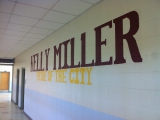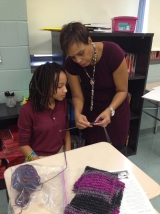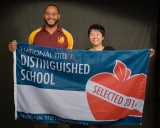-
Category 2
Selected in 2014
-
Grades: 6 - 8
School Setting: urban
Town Population: 0
Student Enrollment: 555
Student Demographics:
Black/African American: 97%
Teacher/Student Ratio: 1:26
White/Caucasian: 0%
Hispanic: 3%
Hawaiian/Pacific Islander: 0%
Asian: 0%
Native American: 0%
Other: 0%
% Reduced Lunch: 99%
% ELL Learners: 1%
Founded: 2004 -
PRINCIPAL:
Abdullah Zaki -
CONTACT:
301 49th Street, NE
Washington , DC 20019
202-388-6870
abdullah.zaki@dc.gov
Kelly Miller Middle School
Washington , DC
Kelly Miller’s vision is built upon the premise that we can extend our impact on student achievement by tapping into the personal interests of the individual student and accelerating curriculum for our higher performing students. Ultimately, we aim to maximize all students’ potential, regardless of their current level of performance.
- Describe specific programs in place to ensure that families are involved in the success of your school and students.
- Describe your philosophy of school change or improvement.
- Schools in high poverty areas that have historically underachieved on standardized state exams normally operate from the standpoint that school improvement will occur through the implementation of strategies and school initiatives geared to build the academic abilities of the lowest performing students. On the surface, this appears to be a solid strategy; however, learning environments characterized by remedial skill building activities, low-levels of student engagement and academic stagnation are created. The common approach to improving school performance in low-income and underachieving schools is to focus on student deficits, but this method does not stimulate student interest, nor does it have the ability to accelerate student learning. Over the past three years, as an organization, our approach to steadily increase student achievement has been to (1) tap to the interests of students and (2) provide students with an accelerated academic experience.
- What is the single most important factor in the success of your school that others could replicate?
-
In order to improve our academic achievement in the areas of ELA and math, we decided to implement an Extended Day Program. During the first year of the program selected students and faculty members remained in school for an additional hour on Tuesdays and Thursdays. The students consisted of our highest and lowest performing students across all grade levels. During this time students received additional ELA and math instruction and support from their teachers. The benefit of the EDP was two-fold:
1. Hard-working, but low performing students were able to develop the necessary building blocks to experience academic success in core content area classes.
2. High achieving students were afforded the opportunity complete independent (but guided) research projects, study complex literature and advanced math concepts and skills.
- Describe the program or initiative that has had the greatest positive effect on student achievement, including closing achievement or opportunity gaps, if applicable.
-
Kelly Miller’s vision is built upon the premise that we can extend our impact on student achievement by tapping into the personal interests of the individual student and accelerating curriculum for our higher performing students. Ultimately, we aim to maximize all students’ potential, regardless of their current level of performance. Toward this end, we have enacted the Enrichment Triad Model developed by Joseph Renzulli, in which high potential students are exposed to topics they are both interested in and that allow them to apply advanced thought processes and skills. This Enrichment Model addresses Renzulli’s Three-Ring Conception of Giftedness, which allows us to further develop our high-potential students’ ability to creatively apply knowledge and skills. In order to keep them interested in school, we must challenge them.
This concept of giftedness addresses above average ability, task commitment, and creativity in our students.
- Describe how data is used to improve student achievement and inform decision making.
- During the 2010 school year, Kelly Miller Middle School adopted an interim assessment tool that allowed our students and teachers to receive student achievement data on a quarterly basis almost instantaneously. The timeliness of the student data allowed teachers to not only reflect on their practices as educators, but it also allowed teachers to make immediate adjustments to their lessons based on the strengths and areas of growth of their students. As result, the core content teachers’ actions became more driven by data and intensely focused on the specific areas of student need. Teachers’ lessons became more aligned with the content standards that were to be addressed during the instructional cycle; thus, students were introduced to the correct and grade appropriate material and more importantly we were able to close the gap between what teachers wanted to teach and what teachers were supposed to teach.
- Describe your school culture and explain changes you’ve taken to improve it.
- Four years ago, Kelly Miller Middle School was characterized by low levels of student engagement, unruly student behavior, lack of systems and procedures and adult apathy. Regardless of the veracity of these perceptions, parental engagement was not a priority; thus, student achievement suffered. To ensure that our vision became a reality, improving parental engagement was on our list of school improvement efforts. Through improving the relationships between faculty and families we have been able to bolster the academic outcomes for our students. As a result, more of our students are academically competitive. We envisioned creating a school community that is built upon the belief that the bond between a school and the families that are served must remain impregnable because once this bond is formed, it is our hope that a path towards greater levels of academic achievement and opportunities for students is unearthed.
Stats
-
Category 2
Selected in 2014
-
Grades: 6 - 8
School Setting: urban
Town Population: 0
Student Enrollment: 555
Student Demographics:
Black/African American: 97%
Teacher/Student Ratio: 1:26
White/Caucasian: 0%
Hispanic: 3%
Hawaiian/Pacific Islander: 0%
Asian: 0%
Native American: 0%
Other: 0%
% Reduced Lunch: 99%
% ELL Learners: 1%
Founded: 2004 -
PRINCIPAL:
Abdullah Zaki -
CONTACT:
301 49th Street, NE
Washington , DC 20019
202-388-6870
abdullah.zaki@dc.gov







